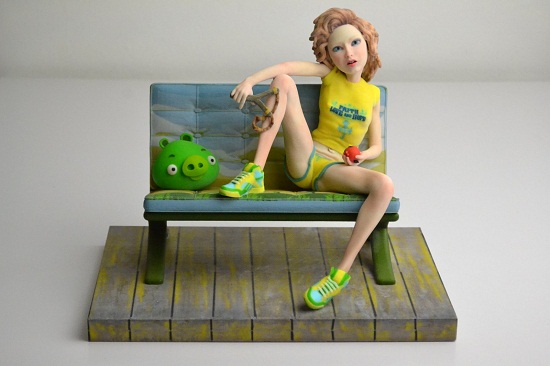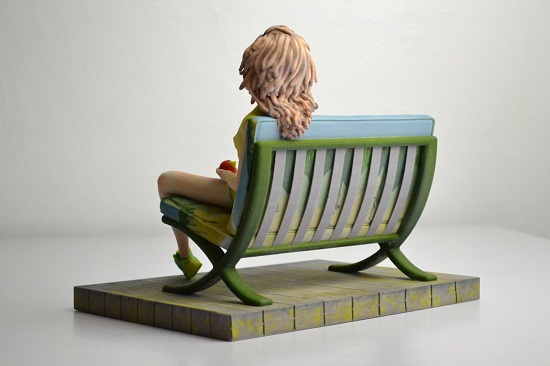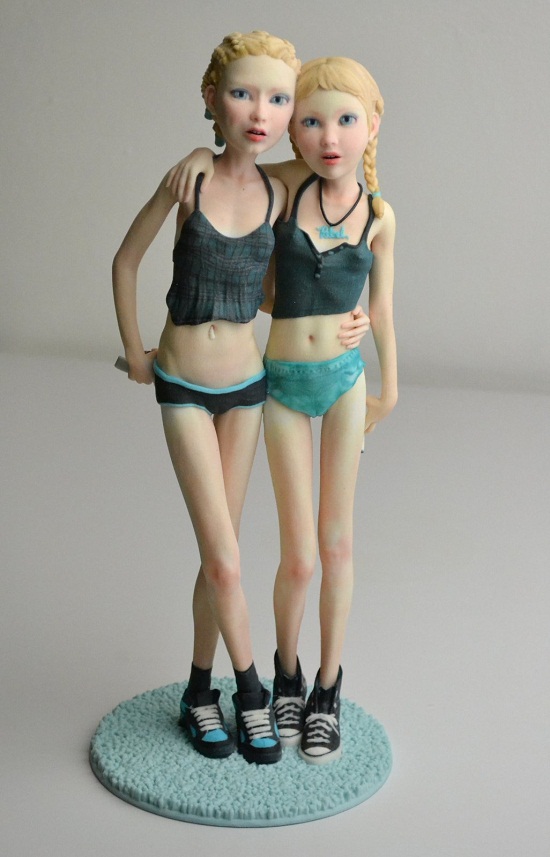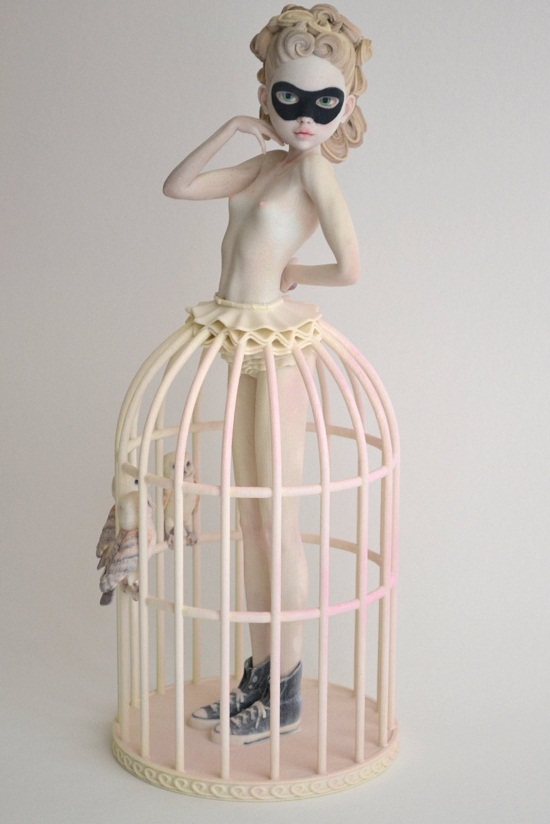Meet the designer: Eric van Straaten
Today we offer you an in-depth look into one of our favorite designers: Eric van Straaten. His multicolor magic has continuously pushed the technology to its limits and has attracted countless of enthusiastic crowds to admire it. Therefore it comes as no surprise that we were more than happy to receive such a deep look into the mind behind the artist. It is with great pleasure that we present you with Eric’s deepest thoughts, feelings and visions told in his own words.
I don’t really think you need much of an introduction anymore as you ‘ve made quite a name for yourself at i.materialise, but what we would like to know is a bit about your background. Tell us a bit about the boy that became the man…
I was born in 1969 in the Dutch city of Leiden and grew up in Haarlem. From the age of about 17 I have always wanted to be an ‘artist’, and after a career that we call in Dutch ’12 trades, 13 accidents’ (more or less successful photographer, musician, actor, journalist, entrepreneur and sculptor in wax and resin) at 40 years of age, I suddenly started to sell my 3D-printed artworks through a couple of galleries that believed in my works.
How did you discover 3D printing?
About four years ago, I was trying to make a commercial so-called ‘BJD’ (a Ball Joint Doll, these are very popular with collectors in Japan) by making a prototype in wax and casting a series in resin. Because of a combination of insufficient training, laziness and perfectionism, this was becoming an ordeal and at that time my partner in love and work Jennifer Hoes, received an invitation to participate in a subsidized workshop at the technology institute TNO in Eindhoven. She suggested that I could participate also and try to make the doll in Rapid Prototyping.
Within about three months I was able to make a printable and working prototype (about four more would follow, see http://youtu.be/emyyB63EC5w for an example) which was displayed at Dutch Design Week in 2009. I also discovered that commerce wasn’t really the thing for me, but had the idea that the technique maybe was the answer to the problems I was having by working by hand in visualizing my artistic ambitions. After some experiments in monochrome materials, I discovered with help of i.materialise the way to directly print in color.
What inspires your works of art?
Artistically, I am mainly inspired by depictions of the human form, and especially women, without to much ‘distortion’ or ‘distraction’ in the technique. Therefore my tastes are a bit ‘old fashioned’ or maybe even kitsch. I don’t like to expressive, abstract or conceptual work. As sculptors I really like Bernini and Furienmeister (a kind of Bernini but then in tiny ivory statues). The artist most important for my own development has been Hans Bellmer, a doll maker and painter in the surrealist movement. I like to be ‘drawn in’ by the scenery, and this happens the most powerful in portraits, I think (I also consider my own works to be more portraits than sculptures).
Art that works for me, is always multilayered. I like it when at first glance, there appears to be just one (mostly beautiful) ‘truth’, but when you look deeper, there is something else going on at the same time. How greater the artwork is, the bigger the difference between the apparent truth and reality of the whole.
Although my tastes are a bit old fashioned, I am a child of my time, so content wise I am inspired by let’s say pop-culture in general, and I think the youth culture in Japan nowadays, the USA from the seventies and Europe from the eighties/nineties provide the most powerful imagery. Needless to say that ‘Lolita’, first conceived by Vladimir Nabokov but now an iconic figure, is important in my work.
Technically I am inspired by the ‘struggle’ to achieve a ‘perfect’ result with limited means. Although working in the digital domain seems to provide you with unlimited means, 3D-printing at this level is a big technical challenge and I like to think of ‘workarounds’ without becoming too much code-minded and more by combining user-friendly combinations of different kinds of software. This feels more like an artistic voyage than a technical one.
Are there any other themes you are interested in exploring?
I am not to interested in political, sociological or any other themes outside myself (I am a bit narcissistic that way). I think my ‘theme’ will always be myself. I struggle with things like sexuality and getting older, love and loneliness, being childish and living like an adult et cetera (all at the same time). Therefore if I change, my work will change, but I am afraid some hang-ups are just to set-in to disappear over time. But you never know…
Your work often seems to portray the same girl in different stages of her life. What can you tell us about this girl? Who is she?
The easy answer is that this girl is ‘the most beautiful girl in the world’, or ‘the most beautiful girl I can create’, at least at this time. For a more in depth analysis I would have to say that the girls are visualizations of my own feelings, fantasies and thoughts. The girl actually looks like someone I used to know and the different ‘portraits’ tell something about what I think of myself in regards to her or women in general, or what I long for, am afraid of, or have lost. Although they look sweet, sometimes I regard them as ‘demons’ that I try to free from my mind. At the same time I care for them and always try to make them independent of myself, and to give them their own ‘voice’ and individuality.
You also often use lots of animals in your work, do they have a specific meaning?
For the most part, I am not quite sure why the different parts in the scenery work together. When I work, I try not to think to much about what I am doing (if I do, it doesn’t work out well) but just go with the flow. So also for me, the explanation is done afterwards. Perhaps the animals provide a way to relate the girl to something like the forces of nature or at least something animalistic. They change or make clear the apparent innocence or vulnerability of the girls. At the same time, they ‘force’ the girls to take some action, sometimes sweet, sometimes aggressive. Some would say that the animals stand for the artist himself and that sometimes he is just a spectator, and sometimes an actor that is guiding (or undergoing) the action.
What made you choose the multicolor material for almost all of your 3D printed work?
Although I think that most materials available in 3D-printing are beautiful and have qualities that can be used for other kinds of artworks, my feeling is that most of them are to specific texture-wise. I you would use them, the texture itself gives an expression to the artwork and becomes part of it. I like art in which the technique is a non-invasive accessory to the impression an artwork has on the viewer. I want the viewer to relate to the scenery, and not to the material. Because of the combination of the soft, porcelain-like quality of the and the life-like impression it gives, multicolor is perfect for this. It even helps: a lot of people think the material is actually marzipan, this sweet material resonates beautifully with the apparent innocence of the girls in my work.
You are known to go on quite a technical journey in order to realize your work… could you describe your workflow and how you manage to reach such an amazing quality?
I think that my main talent lies in making things beautiful in the computer. I use a lot of template-material (for instance a large portion of my shoe collection comes from the Google SketchUp database), but you should see how ugly the parts are I start with. Although technically speaking 3D-printing, especially in multicolor, is a big challenge, I actually think that everyone could do it like I do, if they would set their mind to it. The biggest challenge at this time is that for the most part 3D-models and 3D-modelling software isn’t truly compatible with 3D-printing and that you have to think of various ways to achieve a printable object from the models you create or start with.
Therefore you have to be willing to think really ‘cross-platform’, and not rely on one piece of software. I am every day learning new workarounds to achieve this, but I am not a programmer and even not a ‘real’ 3D-modeller. So if one program doesn’t do what I want, I try to find another one which provides the desired result. My workflow isn’t easily described, because it can go either way and I use a lot of programs, such as: Poser, Daz3D, Carrara, Google SketchUp, 3dsMax, ZBrush, MeshLab. Software I couldn’t do without are Accutrans (a real nice piece of free conversion software), Materialise Magics and DeskArtes 3 Data Expert. Maybe I can give my opinion on how our work could be so much easier? I think that if Materialise would make their ‘shrink wrapper’ more smart, faultless and available as a stand-alone product, within days all 3D-modellers would start to print their work!
Why did you decide to go digital over traditional sculpting?
Digital suits me so much more than doing it by hand! Besides the fact that I am maybe just not that talented to work in handcrafted materials, I am also not very interested in the ‘accidents’ or uncontrollable circumstances that create expressive qualities in more traditional ways of working. I am more interested in works that are as close to reality as possible, with the alienation coming out of playing with sizes and combining non-existent parts in the scenery. I am so pleased that I can make infinite and tiny changes to the models without starting all over again when something doesn’t work. And, if you make a mistake: just undo!
What grand works can we expect to see next or soon?
For the most part the next year or so, I will be focusing on making even more expressive but subtle ‘portraits’ of single figures in the style of my last statue: a variation on the ’14 year old dancer’ by Degas. I really like standing figures that give you a feel of presence without making the scene too complicated. I don’t know where I will go in the future. The digital technique invites me to perhaps do something with animation-sequences. I also would love to combine the multicolor composite with high transparent resins (but they are a bit expensive).
Where can our community find more of your lovely work?
This week, my work is on show at KunstRAI in Amsterdam: http://www.kunstrai.nl/detail_deelnemer.php?d=18&lan=nl
My own website: http://www.ericvanstraaten.com
My Picasa-album where I regularly place pictures of finished works and renders of sketches I am working on: https://picasaweb.google.com/eric.v.straaten/SketchesRendersAnd3DPrintedModels
My YouTube-channel whit some HD-turntables, interviews and fun-stuff: http://www.youtube.com/user/EricVanStraateniPod
In the Netherlands, I am represented by Gallery Majke Hüsstege in Den Bosch: http://www.majkehusstege.nl/kunstenaars-2/kunstenaars-m-z/eric-van-straaten/
In Berlin, I am represented by Strychnin Gallery: http://www.strychnin.com/
The work attached, which is inspired by ‘14 year old dancer‘ by Degas, will be shown the next month at this gallery in Minneapolis: http://www.gallery13.com/
We at i.materialise would like to thank Eric van Straaten for taking his time to provide our community with such a wonderful look into the mind of this great artist. His work is loved by many and its quality can be match by very few. We will continue to look forward to his future work and would strongly advice you to have a closer to look into the man himself through the links provided above. If you like the way his work looks in the pictures, we can promise you that it looks a million times better in person so don’t hesitate to pay him a visit at KunstRai in Amsterdam.
Recommended Articles
No related posts.











